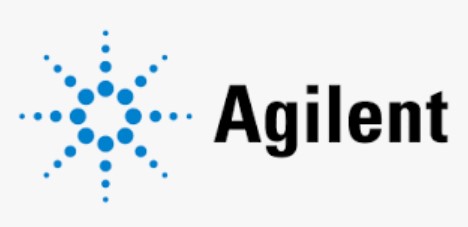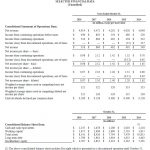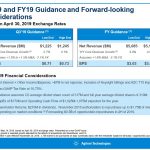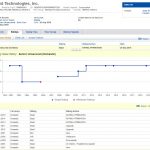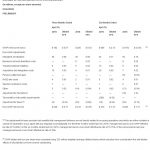Contents
Agilent Technologies, Inc. (A) is a global leader in life sciences, diagnostics and applied chemical markets, providing application focused solutions that include instruments, software, services and consumables for the entire laboratory workflow.
Summary
- A’s sub 1% dividend yield will hold little appeal to dividend seeking investors.
- The company consistently generates positive Free Cash Flow.
- A regularly repurchases outstanding shares with the weighted average number of shares outstanding in FY2009 (~346 million) expected to be down to ~317 million by the end of Q3 2019.
- A recently announced its intent to acquire privately held BioTek Instruments which appears to be a fair price and which will contribute to A’s growth.
- A’s Life Sciences and Applied Markets business segment is experiencing challenges in China which has led management to lower FY2019 revenue guidance. Non-GAAP diluted EPS guidance remains unchanged.
- As much as A appeals to me I fully expect a market pullback of some magnitude in 2019. As a result I am in no hurry to initiate a position in A.
Introduction
Many investors may be unfamiliar with Agilent Technologies Inc. (A) despite it being a company with a ~21.7B market cap.
It was formed in March 1999 when Hewlett-Packard announced a plan to create a separate company that comprised Hewlett-Packard's test and measurement, semiconductor products, healthcare solutions and chemical analysis businesses, related portions of Hewlett-Packard Laboratories, and associated infrastructure.
Business Overview
A is a global leader in life sciences, diagnostics and applied chemical markets, providing application focused solutions that include instruments, software, services and consumables for the entire laboratory workflow.
In 2018, A re-organized its operating segments and moved the microfluidics business from the life sciences and applied markets operating segment to the diagnostics and genomics operating segment. A now has 3 business segments comprised of the life sciences and applied markets business, diagnostics and genomics business and the Agilent CrossLab business.
Life Sciences and Applied Markets (LSAG)
This business provides application-focused solutions that include instruments and software that enable customers to identify, quantify and analyze the physical and biological properties of substances and products. Its solutions also allow customers in the clinical and life sciences research areas to interrogate samples at the molecular and cellular level.
Diagnostics and Genomics (DG)
This business is comprised of 6 areas of activity providing solutions that include reagents, instruments, software and consumables which enable customers in the clinical and life sciences research areas to interrogate samples at the cellular and molecular level.
Agilent CrossLab (ACG)
This business spans the entire lab with its extensive consumables and services portfolio, which is designed to improve customer outcomes.
A conducts centralized order fulfillment and supply chain operations for its businesses through the order fulfillment and supply chain organization (“OFS”). OFS provides resources for manufacturing, engineering and strategic sourcing to our respective businesses.
Each business, together with OFS and Agilent Technologies Research Laboratories, is supported by A’s global infrastructure organization, which provides shared services in the areas of finance, information technology, legal, certain procurement services, workplace services and human resources.
Products are sold primarily through direct sales, but distributors, resellers, manufacturer's representatives and electronic commerce are also used.
As at A’s most recent FYE (October 31, 2018), it employed ~14,800 people worldwide. Primary research and development and manufacturing sites are in California, Colorado, Delaware, Massachusetts and Texas in the U.S. and in Australia, China, Denmark, Germany, Italy, Japan, Malaysia, Singapore and the United Kingdom.
BioTek Instruments Acquisition
On July 11th, A announced that it had signed a definitive agreement to acquire privately-owned BioTek Instruments for $1.165B. The net purchase price is expected to be ~$1.05B when anticipated tax benefits for A are taken into consideration.
BioTek generated revenues of $0.162B in FY2018 with ~10% growth expected in FY2019.
BioTek is a global leader in the design, manufacture and distribution of innovative life science instrumentation. Its comprehensive product line includes cell imaging systems, microplate readers, washers, dispensers, automated incubators and stackers. These products enable life science research by providing customers with high performance, cost-effective analysis across diverse applications.
Additional details can be found in this Press Release.
Selected Financial Data (FY2014 – 2018)
The following selected financial data extracted from A’s 2018 10-K provides a very high level overview of A’s performance in recent years.
Source: A’s 2018 10-K (page 40 of 128)
Q2 2019 Financial Results
A’s Q2 2019 Earnings Release can be accessed here.
A reported mixed Q2 results with the LSAG business experiencing unexpectedly soft market conditions.
Despite revenue below our expectations, EPS of $0.71 (midpoint of guidance) was achieved. This represented 9% EPS growth over Q2 2018 and also marked the 17th consecutive quarter of adjusted operating margin expansion.
Total revenues amounted to $1.24B representing 4% core growth.
ACG experienced core growth of 9%; DG delivered 6% core growth, and LSAG declined 1%. Two key market factors were observed in the latter part of Q2 that contributed to the LSAG revenue shortfall.
- a slowing of internal orders in China;
- more of a general slowdown in orders from big pharma.
This slowdown became apparent at the beginning of April.
In China, overall business grew 3%, but the LSAG business declined by 1% in Q2 because:
- the recovery in the food market has not yet materialized and government labs had not yet resumed purchasing at previous levels;
- the Chinese government's 4 + 7 initiative to lower generic drug prices is having a greater than expected impact on small molecule pharma.
Given the above, A has lowered its revenue expectations in China for FY2019. China does, however, remain an important long-term growth market.
Another factor affecting LSAG growth is moderating global demand in small molecule pharma. A has witnessed several large accounts delay their purchases. In contrast, the small molecule pharma continues to see strong global bio-pharma demand. While overall growth declined 1% there are positive signs in other LSAG end markets with demand remaining strong in environment forensics and biopharma markets and solid results in chemical and energy.
ACG grew 9% with demand being broad-based across all regions. In China, the ACG business grew in the mid-teens. The ACG team continues to leverage A’s large instrument installed base and continues to expand A’s footprint in emerging cities and to tailor to local markets.
DG grew 6% with regional demand led by strength in the Americas. The pathology related businesses grew high single-digits and large competitive wins along with continued strong demand for A’s antibodies and companion diagnostic services are driving growth in this segment. A also received expanded FDA approval for its PDL1 IHC companion diagnostic for metastic non-small cell lung cancer; this companion diagnostic is expected to now be used to identify a broader range of patients who may qualify for first-line treatment with Keytruda.
FY2019 Guidance
Guidance can be found on page 8 of 8 in the Q2 2019 Earnings Presentation.
Source: A - Q2 Earnings Presentation – May 14 2019
In the 2nd half of FY2019, management has indicated it is confident the momentum will continue in ACG and DGG businesses. The outlook for the LSAG business in the 2nd half, however, is tempered by management’s view of continued soft market conditions. Given this, the outlook for FY2019 has resulted in management reaffirming prior full-year EPS guidance while lowering revenue growth.
At the time of Q2’s Earnings release, A expected Q3 revenue in the range of $1.225B - $1.245B with Q3 non-GAAP earnings expected to be $0.71 - $0.73/share.
Full year revenue guidance was revised lower to $5.085B - $5.125B from the previous $5.15B - $5.19B presented February 20 when Q1 results were released.
Non-GAAP diluted EPS guidance remained unchanged at $3.03 - $3.07/share.
Disciplined expense management is expected to continue and the plan is to repurchase $0.5B of shares (see guidance image above) with average diluted share count expected to be down to 319 million shares for the year; the weighted average shares used in computing diluted net income per share in FY2018 was 325 million shares.
Q3 revenue is expected to be $1.225B - $1.245B and Q3 non-GAAP earnings are expected to be in the range of $0.71 - $0.73/share.
Q3 share count is expected to be ~317 million.
Credit Ratings
A’s current debt ratings can be found here.
The following reflects A’s senior unsecured long-term debt credit ratings assigned by Moody’s over the course of time.
Moody’s currently rates A’s senior unsecured long-term debt Baa2 which is the middle tier of the lower medium grade category.
Standard & Poor’s assigned a BBB+ rating in December 2011 and this rating is still in effect. This rating is one notch higher than that assigned by Moody’s.
Fitch has also assigned a BBB+ rating.
Liquidity and Capital Resources
As at FYE2018 (October 31, 2018), A’s financial position consisted of cash and cash equivalents of $2.247B compared to $2.678B as of October 31, 2017.
As of October 31, 2018, ~$1.361B of A’s cash and cash equivalents was held outside the U.S. by foreign subsidiaries.
In 2018, A repatriated $1.921B of the cash held outside the U.S. The cash remaining outside the U.S. can be repatriated to the U.S. as local working capital and other regulatory conditions permit. As a result of the Tax Cut and Jobs Act, A’s cash and cash equivalents are no longer subjected to U.S. federal tax on repatriation into the U.S..
Free Cash Flow (FCF)
I view FCF as a critical metric. In FY2014 – 2018, A generated $0.53B, $0.41B, $0.65B, $0.71B, and $0.91B in FCF. I am reassured that A can consistently generate positive FCF.
Dividend and Dividend Yield
Investors who place a high priority on dividend income from their investments will most likely rule out A as a potential investment once they look at A’s dividend history. Furthermore, the $0.164 quarterly dividend ($0.656/annually) provides investors with a sub 1% dividend yield on the basis of A’s current $68.70 share price as at the close of business on July 19.
I am of the opinion that A’s dividend is likely of little importance when analyzing A as a potential investment, and therefore, I will dispense with further comment on this subject matter.
If you have any interest in potentially investing in A you may wish to access the Investment Calculator to determine how A shareholders have fared over time.
Valuation
A has generated $2.13 in diluted EPS and $1.47 in non-GAAP diluted EPS for the first half of FY2019.
Guidance from 16 brokers ranges from $3.04 - $3.07 with the current mean being $3.06. Using A’s FY2019 Non-GAAP diluted EPS guidance of $3.03 - $3.07/share and the current $68.70 share price we get a forward adjusted PE range of ~22.38 - ~22.67.
Management does not provided unadjusted EPS guidance but if we estimate that FY2019 diluted EPS will come in between $3.70 - $3.80 then the forward PE range is ~18.08 - ~18.57. By comparison, A’s PE ratios for the 2010 – 2018 timeframe were 23.41, 12.26, 12.52, 27.23, 27.48, 31.92, 32.54, 31.89, and 69.55. Clearly, A’s valuation has fluctuated widely but my ~18.08 - ~18.57 projected range suggests A is currently reasonably valued.
Final Thoughts
While A will likely hold little appeal to investors seeking a reasonable level of dividend income from their holdings I seek a balance of dividend income and growth. A sub 1% dividend yield, therefore, does not concern me when I think there is reasonable growth potential.
I recognize A is experiencing challenges in its LSAG operating segment which has contributed to a pullback in the share price from its 52 week high of ~$82 set mid March 2019.
I do not envision A’s challenges in China coming to an end anytime soon but I am confident that management is taking appropriate measures.
Although A appeals to me and I intend to initiate a position at some point, I have mentioned in several previous recent articles that I fully expect a market pullback of some magnitude in 2019. As a result, I am in no hurry to initiate a position in A.
I hope you found this article helpful and wish you much success on your journey to financial freedom.
Thanks for reading!
Note: I sincerely appreciate the time you took to read this article. Please send any feedback, corrections, or questions to [email protected].
Disclaimer: I have no knowledge of your individual circumstances and am not providing individualized advice or recommendations. I encourage you not to make any investment decision without conducting your own research and due diligence. You should also consult your financial advisor about your specific situation.
Disclosure: I do not currently hold a position in A nor do I intend to initiate a position within the next 3 business days.
I wrote this article myself and it expresses my own opinions. I am not receiving compensation for it and have no business relationship with any company whose stock is mentioned in this article.


